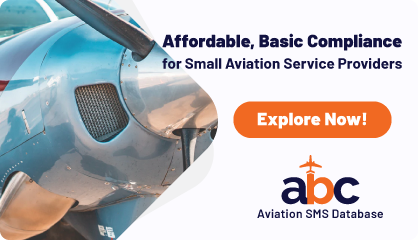
In aviation, where safety is non-negotiable, a Safety Management System (SMS) is the backbone of risk management. Mandated by the International Civil Aviation Organization (ICAO) and national regulators like the FAA and EASA, an SMS provides a structured top-down approach to identifying, assessing, and mitigating safety risks. However, a one-size-fits-all SMS is ineffective—aviation operations vary widely in size, complexity, and risk profile.
Tailoring an SMS to your organization’s unique characteristics is essential for compliance, operational efficiency, and a robust safety culture. This article offers aviation safety managers actionable guidance on customizing SMS implementations, with insights into regulatory requirements, practical steps, and best practices.
Why Tailoring Aviation SMS Matters
An aviation SMS is a systematic framework that integrates safety policies, risk management, safety assurance, and safety promotion. ICAO Annex 19 requires SMS to be “appropriate to the size and complexity” of the organization, a sentiment echoed in FAA’s 14 CFR Part 5 and EASA’s regulations. Based on the reader's perspective and experience, this "appropriate to the size and complexity" becomes obviously subjective.
A tailored SMS ensures:
-
Relevance: Addresses specific hazards relevant to your operation, whether you’re a small general aviation operator or a major airline.
-
Compliance: Meets regulatory expectations for proportionality and effectiveness.
-
Efficiency: Optimizes resources by focusing on high-priority risks.
-
Engagement: Fosters a safety culture by aligning processes with your team’s operational reality.
Without customization, an SMS risks being overly complex for small operators or insufficiently robust for large ones, leading to inefficiencies, non-compliance, or safety gaps. Below, we explore how to tailor an SMS to your organization’s size, complexity, and risk profile.
Understanding Size, Complexity, and Risk Profile
Before tailoring an SMS, define your organization’s characteristics:
-
Size: Refers to the scale of operations, including the number of employees, aircraft, flights, or facilities. A single-pilot charter service is “small,” while a global airline with thousands of employees is “large.”
-
Complexity: Relates to the intricacy of operations, such as fleet diversity, international routes, or integration of advanced technologies. A regional airport is less complex than a major hub with multiple runways and air traffic control systems.
-
Risk Profile: Encompasses the specific hazards and their likelihood/severity, influenced by factors like geography, weather, traffic density, or operational type (e.g., cargo vs. passenger).
Example: A small heliport in a mountainous region has a low size and complexity but a high-risk profile due to terrain and weather. Conversely, a large airline operating globally has high size and complexity, with a risk profile shaped by fleet diversity and regulatory variations.
Related Articles on Aviation SMS Implementation
- SMS First Steps - How to Create an SMS Implementation Plan
- Why Should We Implement Aviation SMS?
- Overview of 4 Phases of Aviation SMS Implementation With Free Resources
Steps to Tailor Aviation SMS to Your Organization
Customizing an SMS is a strategic process that aligns safety processes with operational realities. Follow these steps to create an effective, proportional SMS.
Step 1: Assess Your Organization’s Characteristics
Conduct a thorough assessment to understand your size, complexity, and risk profile.
-
Size Evaluation:
-
Count employees, aircraft, and annual flights.
-
Assess infrastructure (e.g., number of hangars, runways, or terminals).
-
Example: A general aviation operator with five pilots and three aircraft is small, while an airline with 200 pilots and 50 aircraft is large.
-
-
Complexity Analysis:
-
Map operational components, such as flight operations, maintenance, ground handling, or air traffic control.
-
Identify variables like international operations, mixed fleet types, or advanced technologies (e.g., drones).
-
Example: A cargo operator with a single aircraft type is less complex than an airline with multiple aircraft types and global routes.
-
-
Risk Profile Mapping:
-
Use historical data (incident reports, audits) to identify recurring hazards.
-
Consider environmental factors (e.g., weather, terrain) and operational risks (e.g., runway incursions, mechanical failures).
-
Engage stakeholders (pilots, maintenance crews, managers) to capture frontline insights.
-
Example: An airport in a bird migration path has a high risk of bird strikes, while a tropical operator faces frequent thunderstorm-related hazards.
-
Tool: Leverage ICAO’s Safety Management Manual (Doc 9859) or FAA’s SMS Gap Analysis Tool for structured assessment templates.
Step 2: Define SMS Scope and Objectives
Establish the scope of your SMS based on your assessment, ensuring it’s proportional to your organization’s needs.
-
Small Organizations:
-
Focus on core SMS components: basic safety policies, hazard identification, and simple reporting systems.
-
Example: A single-pilot operator might have a one-page safety policy and a digital log for hazard reports.
-
-
Large Organizations:
-
Implement comprehensive SMS with detailed policies, integrated risk management tools, and robust assurance processes.
-
Example: A major airline might use software for real-time risk tracking and conduct quarterly safety audits.
-
-
Complexity Considerations:
-
Low-complexity operations can use streamlined processes, like manual risk assessments.
-
High-complexity operations require advanced tools, such as predictive analytics or cross-departmental safety committees.
-
-
Risk Profile Alignment:
-
Prioritize resources for high-risk areas. For example, a heliport in a windy region might emphasize wind shear training, while a busy airport focuses on runway safety.
-
Best Practice: Document your SMS scope in a Safety Policy Statement signed by senior management to demonstrate commitment.
Step 3: Customize SMS Components
Tailor the four SMS pillars—safety policy, risk management, safety assurance, and safety promotion—to your organization.
Safety Policy
-
Small/Low-Complexity: Develop a concise policy outlining safety objectives, roles, and reporting expectations. Example: A small flight school might state, “All instructors report hazards within 24 hours.”
-
Large/High-Complexity: Create detailed policies with clear hierarchies, such as a safety committee for oversight. Example: An airline might define roles for a Chief Safety Officer and departmental safety leads.
-
Risk Profile: Include commitments to address specific risks, like “mitigating bird strike hazards” for an airport.
Resource: Use FAA’s SMS Voluntary Program templates for sample safety policies.
Risk Management
-
Small/Low-Complexity: Use a simple risk matrix (e.g., 3x3) with basic severity/likelihood criteria. Conduct manual hazard assessments during team meetings.
-
Example: A charter operator might assess risks like “fuel contamination” using a spreadsheet.
-
-
Large/High-Complexity: Implement a 5x5 risk matrix with detailed criteria and automated tools for risk tracking.
-
Example: A major airport might use software to monitor runway incursion risks in real time.
-
-
Risk Profile: Customize risk criteria to reflect operational hazards. For instance, a cargo operator might prioritize “load shift” risks, while a heliport focuses on “low-visibility landings.”
Tool: Adapt risk matrix templates from IATA’s SMS Implementation Guide or SKYbrary’s Safety Management Toolkit.
Related Articles on Aviation SMS Risk Matrix
- What Is a Risk Matrix and Risk Assessment in Aviation SMS
- How to Define Severity and Likelihood Criteria on Your Risk Matrix
- How to Create Your Risk Matrix for Risk Assessments in Aviation SMS
Safety Assurance
-
Small/Low-Complexity: Conduct informal audits (e.g., annual reviews) and track performance with basic metrics, like “number of reported hazards.”
-
Example: A small operator might review safety logs yearly.
-
-
Large/High-Complexity: Establish formal audit programs, data-driven performance indicators (e.g., “incident rate per 1,000 flights”), and continuous monitoring systems.
-
Example: An airline might use dashboards to track compliance across fleets.
-
-
Risk Profile: Monitor metrics tied to key risks, such as “bird strike incidents” for an airport or “maintenance errors” for a repair station.
Tip: Use NBAA’s SMS Toolkit for assurance metrics tailored to business aviation.
Safety Promotion
-
Small/Low-Complexity: Promote safety through regular team briefings and posters. Example: A flight school might hold monthly safety talks.
-
Large/High-Complexity: Implement comprehensive training programs, newsletters, and safety campaigns. Example: An airport might launch a “Runway Safety Week.”
-
Risk Profile: Tailor training to address specific risks, like “thunderstorm avoidance” for tropical operators.
Resource: Join LinkedIn groups like "Aviation Safety Management Systems," “Aviation Safety Professionals” or follow #AviationSafety on X for promotion ideas.
Step 4: Scale Technology and Resources
Choose tools and resources that match your organization’s capacity.
-
Small/Low-Complexity:
-
Use free or low-cost tools, like spreadsheets for risk tracking or email for safety reporting.
-
Example: A single-pilot operator might use a Google Form for hazard reports.
-
-
Large/High-Complexity:
-
Invest in SMS software (e.g., SMS Pro, ABC) for integrated risk management and reporting.
-
Example: A major airline might use a platform to analyze safety data across global operations.
-
-
Risk Profile:
-
Prioritize technology that addresses key risks. For example, an airport with high traffic might invest in ground radar, while a remote operator focuses on weather monitoring tools.
-
Pro Tip: Explore free resources on Aviation Safety Network (aviation-safety.net) or SKYbrary (skybrary.aero) before investing in paid tools.
Related Aviation SMS Database Software Articles
- 3 Benefits of Aviation Safety Management System (SMS) Databases
- 5 Most Important Things to Know Before Buying Aviation SMS Database
- How Long to Switch to New Aviation SMS Database?
Step 5: Engage Stakeholders
Involve your team to ensure the SMS is practical and embraced.
-
Small Organizations: Hold informal meetings to gather input from all staff. Example: A small operator might discuss SMS during weekly briefings.
-
Large Organizations: Form safety committees with representatives from each department. Example: An airline might include pilots, engineers, and ground staff in SMS planning.
-
Risk Profile: Focus discussions on relevant hazards. For instance, a heliport might prioritize pilot input on terrain risks.
Action Item: Attend events like the World Aviation Safety Summit to network with peers and share tailoring strategies.
Step 6: Validate and Test
Ensure the tailored SMS is effective and compliant.
-
Regulatory Alignment: Cross-check with ICAO Annex 19, FAA Part 5, or EASA standards. Example: Verify that your risk matrix meets FAA’s risk assessment requirements.
-
Scenario Testing: Apply the SMS to past incidents or hypothetical scenarios. Example: Test how a “runway incursion” is managed under your processes.
-
Feedback Loop: Collect input from staff to identify gaps. Example: A pilot might note that reporting forms are too complex, prompting simplification.
Tool: Use EASA’s Management System Assessment Tool to validate SMS components.
Step 7: Monitor and Update
Regularly review and refine your SMS to adapt to changes in size, complexity, or risk profile.
-
Annual Reviews: Assess whether the SMS remains proportional. Example: A growing operator might add new risk criteria as fleet size increases.
-
Emerging Risks: Update the SMS to address new hazards, like drone operations or climate-related weather changes.
-
Continuous Improvement: Use safety assurance data to drive refinements. Example: If audits show under-reporting, simplify reporting processes.
Tip: Subscribe to IATA or FAA newsletters for updates on SMS best practices.
Challenges and Solutions
Tailoring an SMS can present challenges. Here’s how to address common issues:
-
Challenge: Limited resources for small operators.
-
Solution: Use free templates from ICAO, FAA, or SKYbrary and focus on high-impact risks.
-
-
Challenge: Overcomplicating SMS for large operators.
-
Solution: Prioritize scalable processes and phased implementation (e.g., start with risk management, then add assurance).
-
-
Challenge: Resistance to change.
-
Solution: Highlight benefits (e.g., improved safety, compliance) and involve staff in customization to build buy-in.
-
Conclusion
Tailoring an SMS to your organization’s size, complexity, and risk profile is a regulatory requirement and a strategic imperative for aviation safety managers. A customized SMS ensures relevance, compliance, efficiency, and engagement, strengthening your safety culture and operational resilience.
By assessing your organization, defining a proportional scope, customizing SMS components, scaling resources, engaging stakeholders, and continuously improving, you can build an SMS that fits your unique needs.
Start by evaluating your current SMS against your operational characteristics. Leverage resources from ICAO, FAA, IATA, or SKYbrary to guide customization.
Involve your team to foster ownership and stay proactive in updating your SMS to address emerging risks. With a tailored SMS, you’ll enhance safety, meet regulatory expectations, and protect your operation in the dynamic world of aviation.
Remember, if you need an SMS Partner with excellent, user-friendly tools to facilitate SMS compliance, SMS Pro has your back.








